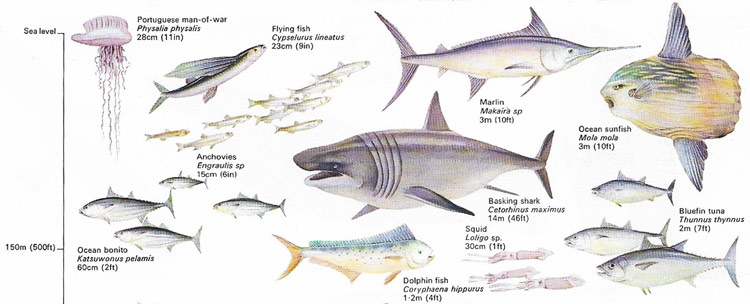euphotic zone

Throughout the top 200 m (650 ft) of the ocean planktonic plant life of many different forms is found accompanied by the primary feeders that live on them. These tend to travel about in shoals, in the wake of the greatest concentration of plankton, and are in turn eaten by small predators. These then fall prey to larger predators like sharks, which spend most time in the middle or the mesopelagic zone of the open ocean.
The euphotic zone is the uppermost layer of the oceans, extending down to a depth of about 200 m. Much light penetrates this comparatively shallow zone, and many green plants and herbivores are found there, and often sea-dwelling mammals.
Among the most common of zooplankton found in the euphotic zone are copepods, krill, and other small crustaceans, but other forms include eggs and larvae of many sea creatures, worms, comb jellies, sea snails, and jellyfish. The smallest zooplankton are the chief herbivores of the ocean, grazing on the microscopic plants or phytoplankton that form the basis of the ocean food chains. Larger zooplankton, including small fish and also invertebrates such as large jellyfish, live either as carnivores or as detritus or 'carrion' feeders living on any dead matter.
All parts f the ocean are inhabited by fish, but those of the superficial euphotic zone are largely zooplankton feeders and many are small, immature fish that are themselves the prey of larger fish. The herrings (Clupea spp) and their allies, however, consume phyoplankton as a significant proportion of their diet. It is because they can use the ocean's plant resources that the herrings provide the bulk of the human ocean harvest.
While fish can swim in search of food, many large jellyfish are passive surface drifters. The Portuguese man-of-war (Physalia physalis) has a float with a 'sail', which puts it at the mercy of the sea winds.
The number of small fish in the euphotic zone tends to increase at night. These fish migrate upwards from the lower pelagic zone and this migratory movement seems to be a protective mechanism because predators are generally less active during the hours of darkness. In addition, these migrations help the small fish to conserve their energy resources, for by moving into deeper, cooler waters in daytime they metabolize their food more slowly because their body temperatures are lower.
At night the upper layer of the ocean is illuminated by the light prodiced biologically by the constituents of the plankton. It has been suggested that ratether than putting the plankton at a diadvantage it protects them, for the light makes plankton feeders such as small fish easily visible to the larger ocean carnivores; the very presence of fish seems to excite the plankton into light production.
Sea-dwelling mammals, such as whales, dolphins, and seals, can dive deep into the ocean, but regularly inhabit the uppermost layer of the open ocean because they must come to the surface to breathe. The baleen whales are further limted by the distribution of their food supply.


